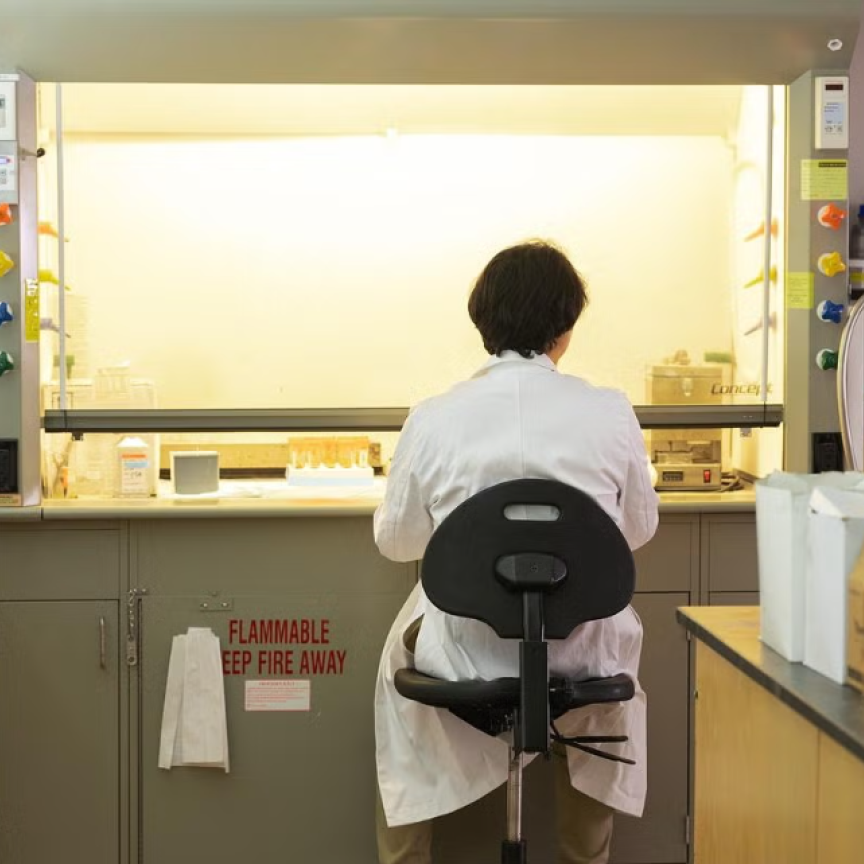Solar power is plentiful and promises endless amounts of energy from our solar system’s Sun that should burn for many more billions of years, but the road to this future of power through light harvesting that is too cheap to meter is proving harder than anyone expected.
‘It’s increasingly more complicated than you imagine it; the big news story ten years ago was probably hopelessly naïve in terms of what plasmonics could achieve. Implementation inside a real device is very problematic. We think we know what we need to do to make the best devices, but it’s hard to integrate it in an actual device process,’ says Professor Darren Bagnall, head of the Nano Research Group at the University of Southampton. Plasmons can be described as an oscillation of free electron density with respect to the fixed positive ions in a metal. In this case a metal nanoparticle. ‘We started working on it eight or nine years ago.’ Bagnall continues, ‘Ten years ago there was a lot of excitement to use metal nano particles to enhance the efficiency of solar cells. People have learnt a lot and looked at all sorts of structures and ways you can use plasmons. People at various institutes have shown the enhancements in the performance of certain types of solar cell, solar cell designs.’
The idea is that a metal nanoparticle interacts with a photon and this creates a strong field in the nanoparticle that prolongs the plasmon state giving the cell a better chance of absorbing the photon. With this improved photon absorbed the nanoparticle will still re-emit the photon, but this emission is scattered and the way in which this happens is viewed as improving the light trapping properties of the cell. This is because the photons are scattered sidewards. This has the advantage of lengthening the absorption period, giving the cell more time to trap the light. Finally, solar cells need to be anti-reflective so they are simply not bouncing back the photons. The prolonged presence of the photon, because of the plasmon interaction and the sideward scattering, helps to prevent reflection. ‘The light trapping benefit for a solar cell is that where it is hard to absorb the near infrared you ought to be able to get an efficiency enhancement,’ explains Bagnall.
However, one drawback of this is that there is always some intrinsic absorption, also called parasitic absorption. This means about 10 per cent of the photons inside the nanoparticles will be lost to the nanoparticles and that is deemed by the scientists to be the smallest loss possible.
To limit that loss and ensuring that the enhanced field in and around the nanoparticle is achieved with organic solar cells, the nanoparticles need to be in direct contact with the solar cell’s semiconductor material. However, for inorganic silicon solar cells it is a more serious problem because, Bagnall explains, ‘the metal will cause a recombination increase and you will end up losing more carriers than you generated.’
The solution is to put the metal nanoparticles on the back of the solar cell. With this approach the ideal solar cell model is to have a normal antireflective coating, through which most of the first pass of the light works normally, and then the infrared light that has gone through the cell is scattered by the nanoparticles. Because the plasmons are then at the back of the cell their photon capture is prolonged, so the quantum efficiency in the infrared is improved in combination with the scattering.
‘We can use less material, so a 10μm piece of silicon instead of 200μm piece of silicon to make the technology cheaper. That is our line of inquiry to try and design this scattering back-reflector that will work in the infrared where we minimise the absorption and maximise the lateral scattering,’ says Bagnall.
For now the plasmons can scatter 60 per cent of the long wavelength light, but absorb less than 5 per cent. To improve this performance Bagnall’s team has a good idea about the shape, size and position and type of design of the metal nanoparticles and where they need to be in the overall structure. Primarily at the bottom of the cell, how many nanometres they are away from the back-reflector and the semiconductor is a critical factor. To manufacture this layer of well-designed, precisely positioned nanoparticles, electron beam lithography could be used to produce a proof of principle demonstration. The proof of principle work will see lithographic tools used to create the nanoparticles for Bagnall’s team to evaluate. Self organised metal films are preferred for cheap mass manufacture and that will be the next stage, a self organised way of making the particles in solution and then spin them on a substrate. With an organic solar cell the nanoparticles can be embedded in with the solution and can help the scattering and enhanced absorption.
‘There has been a lot of hype over the years and we’ve plodded on to find real answers. So far I haven’t seen anyone show a better solar cell; as far as I know no–one has come up with a solar cell that uses plasmonics that is ready for commercialisation,’ Bagnall explains. ‘Inkjet printing might be a cheap way or nano imprint lithography or annealing of a thin film gives you particles, but none of these things are quite as controlled. You create a wide variety of shapes and sizes that broaden the features and you don’t have control over the tricky problems we have been talking about.’
Another method where inkjet printing is applicable is quantum dots. ‘One can envisage larger volume deposition processes from solution or various printing techniques, for example organic LEDs: it’s been shown you can deposit and pattern those by inkjet printing,’ says University of St Andrews physics and astronomy department professor, Ifor Samuel. His research includes organic solar cells. ‘For solar cells you might use a different coating or printing technology, because you don’t have to pattern them quite so accurately, but you still might use inkjet printing, which we hope would reduce the cost and energy of manufacture.’
Samuel is working as part of an international Anglo-US team through an Engineering and Physical Sciences Research Council grant that includes the University of Glasgow. His US counterparts are the US government’s National Science Foundation and the University of Massachusetts at Amherst. ‘The idea is to tune the properties of the material to make better solution-processed solar cells. Processed for solution, the organic semiconductor and colloidal quantum dots could be deposited from solution because it is a very simple process. It’s very suitable for large area and low cost,’ Samuel explains.
The reason the team is looking at quantum dots is that their absorption can be tuned by changing their size. This means their absorption can be complementary to the absorption of the organic materials used in the solar cell. Those other materials include flavins, which are naturally occurring pigments. ‘We are working on flavins as a new class of acceptor and there we’re aiming to tune energy levels which should make the cells more efficient by increasing their open circuit voltage. Typically we’re trying to get the absorption to be where we want it, and where we want it depends on the solar spectrum because we want to absorb sunlight,’ says Samuel.
His researchers are making hybrid solar cells, part semiconductor quantum dots and part organic semiconductor. This is because they want the two different components to have complementary absorption spectrum. The problem they face is that, whether it is molecules, polymers or quantum dots they all have a limited width of absorption. They absorb over a much narrower spectral range than the solar spectrum and so the cell absorbs much less of the incident light than would be preferable. ‘So by having materials that absorb slightly different areas of the solar spectrum we could absorb more of it and that is the idea we are pursuing in our grant,’ says Samuel.
For a single junction solar cell an energy gap of around 1.5eV is optimal, absorption in the near infrared is desirable and quantum dots are a route to achieving that.’
As well as using inkjet printing to manufacture such cells, spin coating is another method being investigated. An active layer of the solar cell is created by mixing up the constituents in a solution and spin coating the solution onto a substrate. A few drops of the active layer material to become the coating is placed on top of the substrate and the machine spins the substrate at a couple of thousand revolutions per minute. This spreads the solution uniformly over the substrate delivering a very uniform thickness on the order of 100nm. ‘That’s basically the solution process, that is the aim, very cheap manufacture. This is what we require for organic optoelectronic devices,’ says Samuel. ‘Our project is exploring new classes of materials, so really it’s about exploring alternative approaches and unfortunately any approach, even a good one, needs many years of development to compete with long established approaches.’
Samuel expects these materials to be used to make solar cells so flexible they can be applied to curved surfaces such as rucksacks. Soldiers could have rucksacks that charge up the batteries that are needed by the warfighter for equipment such as nightvision goggles.
3D-Micromac develops and manufactures complete production lines as well as integrated modules for the production of organic photovoltaics. Flexible organic solar cells are made up of carbon compounds. The structure of the solar cells is either generated by a printing process or highly precise laser scribing, already successfully used elsewhere in photovoltaics. Flexible organic solar cells are made up of carbon compounds. Flexible organic solar cells constitute an alternative to common mono and polycrystalline solar cells as well as the thin-film technologies. And the production of organic solar cells is much less problematic in this context.
Eventually Samuel expects his quantum dot using hybrid cells to deliver above 10 per cent efficiency, which is just below the 12 per cent commercial cells achieve today. Bagnall foresees plasmonics as a key component for the 30 per cent efficient device that would mean solar power would be available for all. ‘It would be a simple structure based on a mature technology.’


